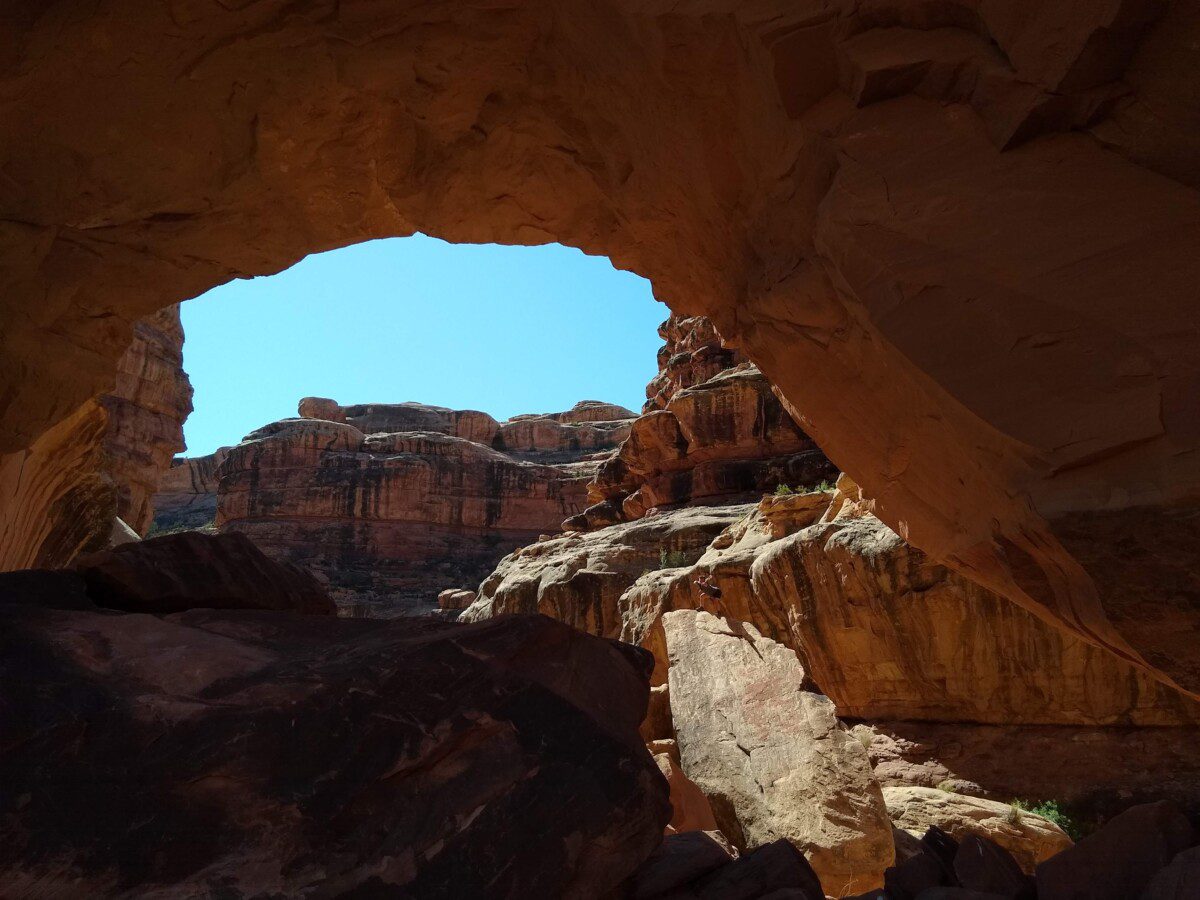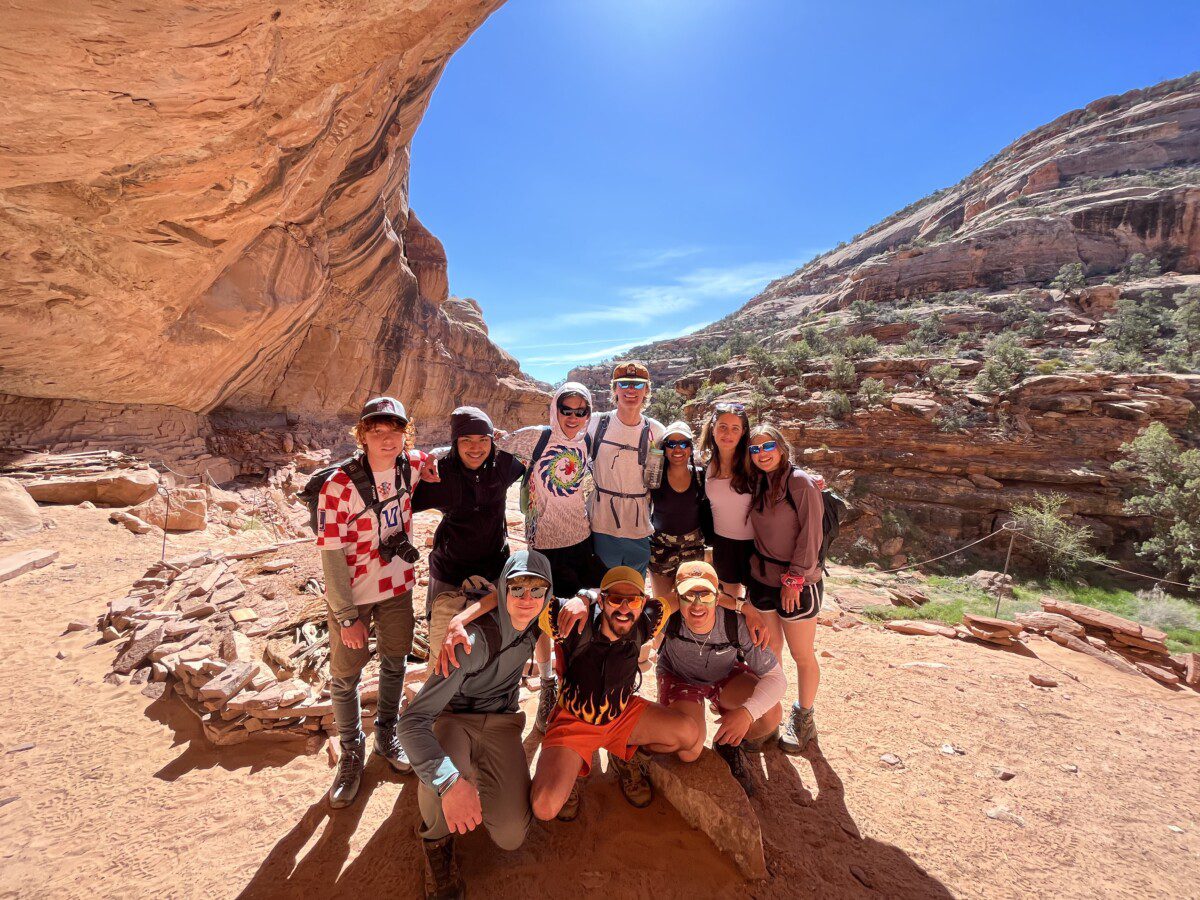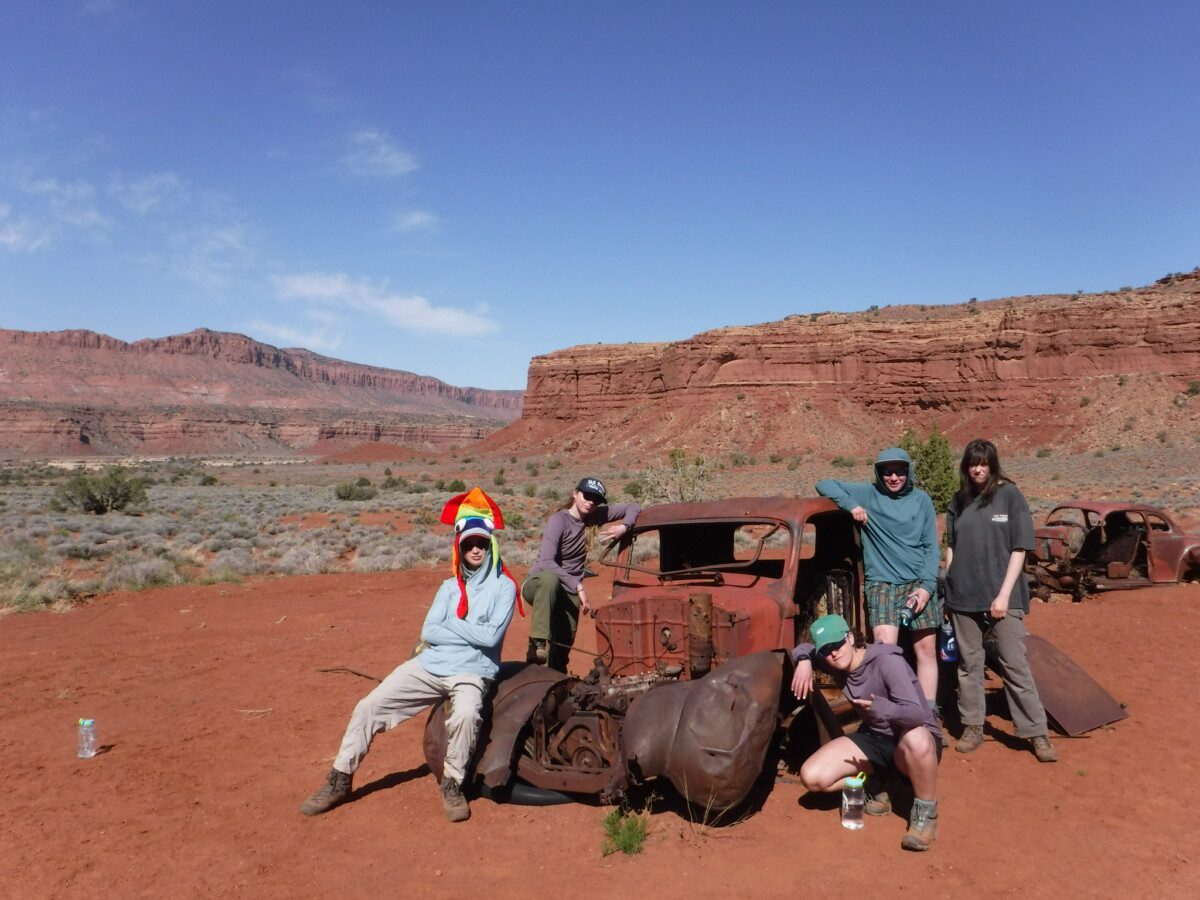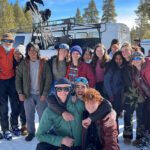Semester 50: Third Expedition
- Posted by High Mountain Institute
- Categories Semester
- Date May 15, 2023
By Rafa, Beckett, Coby, Griffin, & Suzanna
Rafa:
The Third Expedition flew by. From April 19th, 2023 to May 1st, 2023, it was definitely a time to remember. To be fairly honest, I believe that this was one of the most challenging things I’ve done physically. After prepping for two days, everyone was excited to go on an expedition as it was our last one but also more enjoyable as we’re not in the freezing cold anymore. Our drive to the Canyons of Utah was not bad, but it was definitely long which took about 8-9 hours. After arriving, we went right into cooking dinner and going to bed for an early day the day after. The next morning, we all cooked breakfast and got back on the bus to get our permit to camp in the canyons of Utah. After all that paperwork was completed, we now officially began our 12-day trip. The first day was fairly uneventful but was more relaxed compared to the upcoming days. The next day, we would go down into the canyon. Our backpacks were extremely heavy which is not convenient when you’re trying to walk down a canyon. We made it to the bottom of the canyon, which was very tiring, and then proceeded to walk three miles to our next destination. As we were arriving at our destination, we happened to see ruins from Natives who lived in the canyons roughly 800 years ago, before the colonization of America. We would then arrive at our next destination and set up our camp. We would take a layover day, work and even had WFA, which stands for Wilderness First Aid. Third Expedition works a lot differently than the rest. Because many of us have honed our skills for backpacking and camping, there is IST which stands for Independent Student Travel (I know, HMI uses so many acronyms!). The WFA classes would prepare us for any possible scenarios related to medical obstacles. After our layover day, we would now have our first day of IST. The canyons were so warm, if I had to estimate the temperature it would have to be high 70s which is rare especially since we’ve spent a lot of time in Leadville. Applying sunscreen, sunglasses and avoiding dehydration was a priority! The next day would be a 5-mile hike which had to do with a lot of bouldering which brought us to a beautiful campsite where we would have another layover day. At this point, it is still very challenging to carry my backpack which is still heavy. Our group noticed a nice watering hole which we would jump into after doing classes. The instructors would then inform us that the next day would be a fourteen hour, 8-mile hiking day because of the challenging terrain. This means going to bed at around 8pm and waking up at 5:45am in order to get a good start on the hike. The first mile was fine, in which we would see the San Juan River running through the canyons. We would then have to take our time hiking right along the rocks near the San Juan. Cautiously stepping along the rocks, there were multiple instances that felt unbearable. As we were approaching an intersection of the canyon, we would proceed our hike and have to do a pulley system. This system would be used to pull our 60 pound bags up a cliff. We would clip our bags onto a rope and have to pull our bags one by one 12 times. You can imagine after a long day, a pulley system is not ideal. Although it was extremely challenging, I can tell that everyone felt accomplished. We would then arrive at our campsite and now I can feel the sandy grains of the canyons now after a week in. However, we would now follow this long day with another 8-mile day. This day we had a lot of time stepping in water from the Grand Gulch which was not ideal for our boots but ideal for the sake of time. At HMI, this is where a lot of the bonding comes from, it comes from spending time together in rough times like long hikes and spending time cooking dinner as a group. I was content with the group of people I had in this group, specifically because there were a couple of individuals who I would’ve liked to talk to. Once again, we would have a layover day at this beautiful arch that also had petroglyphs drawn on the rocks. It’s crazy to imagine that people, at one point, inhabited the area that we were camping in. After a very productive day, we would soo have one more hiking day to our second to last destination which was about 6-7 miles. The entire group was already very exhausted from all of the hiking done so after this hike, we were all extremely tired but proud of one another. I am convinced that we had the most challenging route out of all the other groups. The 12-day trip would soon come to an end and it would wrap my three expeditions during my time at HMI. Me being from the Bronx, I am grateful for taking up on this opportunity. It’s not everyday that you see the tallest peak in Colorado everyday, or look at the stars when you’re going to bed in your sleeping bag. Yes, of course there will be times where you’re at your lowest but there were also many times where everyone was at their high. Now having the skills and knowledge on how to backpack, ski, camp and do many more activities in the outdoor industry, I will use it to my advantage and do trips of my own with people back at home.

Beckett:
Exped C spent thirteen days starting in Road Canyon, moving around Cedar mesa, and finishing at Lime Creek. This brave bunch of backpackers, including Sam Sanchez, Max Grad, Zoey Egan, Hadley Duncan, Theo Morgan, Beckett Meisel, Blaize Hatfield, Annika Jha, and Kieran Eldridge, went through the highs of swimming and the lows of injury throughout the trip. The first four days were spent in Road canyon. Day two was a layover day after a grueling seven mile trek. During the layover day, the group took a hike, led by Leader of the Day Max Grad, to the citadel ruins. These ruins were nestled on a cliff edge near the top of the canyon. We saw small kivas and structures of brick positioned in small, circular rooms. We also discovered a ton of old pottery spread out across the entire site. Day five, six, and seven were used to get up and out of Road Canyon, traverse along the mesa tops, and finish down into Lime Creek. Day five was a big day for Exped C. We started by climbing up and out of the canyon using pack passing and scrambling techniques. We trekked up and over a mesa top before reaching the drainage. From here we enjoyed lunch while overlooking the cuts and curves of Road Canyon. Cutting in and out of the drainage was a big challenge and took a lot of technical moves. The last part of the hike included a hot walk across a valley, but we got to our campsite with light still in the sky. Day eight, nine, and ten were all hiking days across Lime Creek. Our campsite on day nine included more ancient ruins! Some of us took another little hike up the canyon wall to explore the ancient civilization. Here we found our first and only arrowhead which was super cool! The view from these kivas was also spectacular. We could see across the top of the canyon wall on the other side. We finally reached the bus on day 10 to find it … dead. AAA came and jumped the van, but (to the faculty’s dismay) we had to drive it to Blanding, Utah. Almost like we ended the trip early, our group of students reconnected with civilization in this modest town. We then spent days eleven and twelve at Fish and Owl Canyon. Day twelve was an especially fun day. We set off into Owl Canyon with aspirations of reaching Neville’s Arch, but instead we found the coziest of swimming holes to indulge in. This twelve mile hike turned into a beach day as we all went swimming and sunbathing at the bed of the canyon. An unforgettable way to end our last HMI expedition.

Coby:
Canyon Travel
Have you ever walked at the base of a canyon completely alone?
I have.
On a sunny day in late April, nearing the end of our last excursion into Utah, I found myself at the floor of a canyon. The gray and redish rocks surrounded me, almost as if giving a hug. The hug was only mildly comforting, though, since I could only think about how I was going to get out.
The way I got into the canyon was… Sketchy at best. I hadn’t even really intended to be there, the path I took down was supposed to be a test, I hadn’t expected to lose my footing and slide down the five foot drop—just far enough that getting back up was difficult. But, it ended up being a blessing. Being alone at the bottom of a canyon meant I got to silently observe everything down there. No one else to focus on, no voices echoing, and no expectations.
Climbing back up the way I’d come down, clouds gathered above me. Like some kind of metaphor, the energy at the top had dropped; We were all tired and we had wasted enough time that we were ready to head back to camp. We returned to the canyon the next day, ready to go down (we brought our adult leaders who actually knew where the entrance was), but we never went back to where I was.
That part of the canyon is just mine.

Griffin:
It was like any other day.
We woke up on the ground, our silver and blue foam pads cradling us from the unforgiving slickrock. The sun started to peek over the tops of the red sandy mesas to the east, bringing light to the deep canyons running through the ground like dark veins on a pale stomach. I lift myself up off the ground, reaching towards the sky and sighing. Another day in the canyons. The morning felt like the others: moving to start the stove and boil water. What would we have today? Oatmeal? Granola? The ever sacred hashbrowns?
I knew today was different though. We were going in. Going down. Going deep. Whatever you want to call it. We were going into Gravel Canyon. After 7 days of skirting around it, going in and out of drainages and around curves, we were going in. The plan was simple. Go down into the canyon to the second lowest shelf, walk in the bottom of the canyon for 4 miles, then take a left at the big drainage and hike up to camp. Little did we know that that small 5 mile day would end up taking us over 14 hours.
As we descended into the canyon, a sense of joy surged over me. I couldn’t see very far down the canyon but I could tell that walking in the canyon would be cooler than any other hike we had done so far. When we reached the bottom, we set off on our second hiking day of IST (independent student travel), moving over rolls of slanted slickrock and around large boulders. We continued. And continued. And continued. Hitting stop after stop after stop. That first mile took us just under 5 hours. We kept needing help to navigate difficult features such as scooting along a 4 foot wide ledge with a 50 foot drop to the canyon below, and underneath a set of fallen boulders. As we kept walking, we finally got to walk in the bottom of the canyon and at around 5 o’clock we reached the turn to start walking up the drainage.
We started moving up, and as the sky got darker the canyon got smaller. The walls started closing around us, forcing us into a smaller and smaller slot canyon. We stemmed up and over puddles, over massive lodged boulders that needed a handline, and up a steep wall to get up onto one of the sides. By the time we got to the top, we had been using our headlamps and hiking in the dark for about two hours. Our heads were down, our spirits low, our backs tired, and our eyelids heavy. When we got to camp, it was just after 10:30, making it 14 hours, camp to camp, after our 8:30 start time. We cooked a light dinner, then hit the hay (or I guess, the rock).
It was a rough day, but we got through it, and finished out the trip with smiles as wide as the space between mesas on our faces.

Suzanna:
We slept under the stars every night, and during the last few days, it was still light out when we settled down. We lay on slickrock or sand or the forest bed, shoulder to shoulder, head to head, an array of ten brightly colored sleeping bags. We watched planes cut through the rapidly darkening sky above us, our view intercepted by the occasional bat. Someone noted that the planes looked like boats on the ocean, and once that statement was out there, my mind played tricks on me. It was an optical illusion of sorts, lying beneath the endless expanse of clear sky, seeing the contrails mimic wakes. It was a marvelous thing to fall asleep to.
There is something inexplicably simple about nighttime routines on exped. The process of brushing teeth, changing socks, smoothing greasy hair, and jotting down a few paragraphs about our day in the canyons brings a sense of calm irreplicable anywhere else. Near the end of our 13 days in Utah, my nighttime routine included being taped up in my sleeping bag, for my zipper had officially broken beyond repair. I never slept cold, though. My -20° bag was ample protection for the April nights that barely dipped below 50°. It was spectacular. I slept with my torso out of the puffy warmth, walking the fine line between too hot and too cold. It was something I looked forward to each day–no matter the mileage, the temperature, the amount of strange-looking particles in our water, that moment remained consistent, safe, grounding.


 Semester 50: A Day in the Life
Semester 50: A Day in the Life
 HMI Semester Affinity Spaces
HMI Semester Affinity Spaces